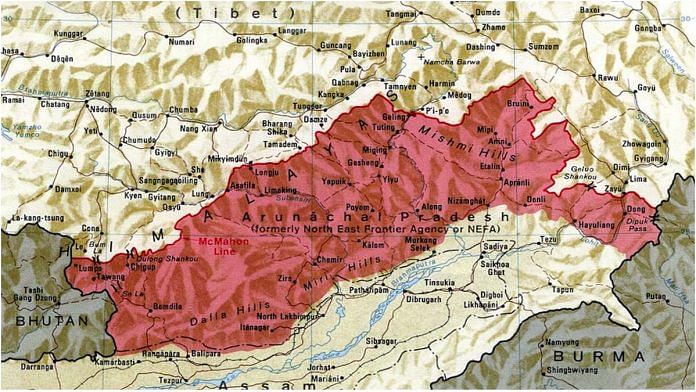Thank you dear subscribers, we are overwhelmed with your response.
Your Turn is a unique section from ThePrint featuring points of view from its subscribers. If you are a subscriber, have a point of view, please send it to us. If not, do subscribe here: https://theprint.in/subscribe/
The 1914 Simla Convention between Tibet and British India that was initialled by Sir Henry McMahon (the then Foreign Secretary in British Indian Government) led to inception of a legal border as per International Law called the McMahon Line for Arunachal Pradesh. The Chinese side has long maintained that their territorial dispute with India is due to the British Indian government legacy. Indian side has maintained always at least for the eastern sector that the McMahon Line can not be disputed under International Law.
India and China signed the Panchsheel Agreement in April 1954. In the same year the Indian government defined the border not just in Ladakh but reaffirming the British Indian government’s McMahon Line too. But Panchsheel Agreement of 29 April 1954 was crafted and carefully worded as the Indian national interest too is observed in it. For example, one of the five principles said ‘mutual respect for each other’s territorial integrity and sovereignty’ it clearly did imply that the border of each country was well known to the other side.
When the Nehru government made McMahon Line public as the official border in 1954 through the Survey of India map (this happened before the Panchsheel Agreement of 29 April 1954), why did the Chinese stay silent? So, Mao Zedong’s Zhou Enlai should have protested to Nehru immediately. As back then had China believed of a territorial dispute on Arunachal Pradesh, that was the time for Mao Zedong to raise with Nehru rather than 1960 (just before the war, it was the last major negotiation when Mao’s Zhou Enlai met Prime Minister Nehru in Delhi). And the irony of the ironies being that the McMahon Line which China refused to accept as official border with India, in case of Burma, the Chinese accepted.
This despite the fact that Chinese had refused to sign the 1914 Simla Convention which Sir Henry McMahon had initiated and it is after him that the border between India and China in Arunachal Pradesh got named as McMahon Line. Prime Minister Nehru on 14 December 1958 wrote to Mao Zedong’s second in command Zhou Enlai “I remember your telling me that you did not approve of this border being called the McMahon line… You told me then that you had accepted this McMahon line border with Burma and, whatever might have happened long ago, in view of the friendly relations which existed between China and India, you propose to recognise this border with India also.” Chinese Communist Party (CCP) since Mao Zedong had always an expansionist impulse, that is they were least interested and bothered about International Law.
If one analyzes the same things from International Relations perspective, one is bound to conclude that Zhou Enlai did not protest in spite of having seen the 1954 Survey of India maps because in 1951 the Chinese had occupied Tibet in its entirety. So, they were trying to solidify their communist grip over Tibet while decimating the traditional, historical and cultural links of Tibet with India.
It was not an easy task for Mao to suppress the Tibetans thirst for freedom, and so his CCP was busy using brute force and killing Tibetans; all this happened in the chaos as the Dalai Lama planned his exit from the clutches of the CCP to take refuge/asylum in India. So, Dalai Lama arrived in India during the year 1959, the same year the PLA started intrusions not just in Arunachal Pradesh (it was August 1959) but Ladakh too killing Indian soldiers. India lost the 1962 war with China due to poor leadership of the Indian Army, Intelligence Bureau Chief BN Mullik, India’s Ambassador to China K.M. Panikkar and Defence Minister V.K. Krishna Menon, all of them misled Prime Minister Nehru to the hilt due to their severe incompetence in assessing China. Yes, the Chinese deception was crafted well in pleasantries but still there were a number of signals the team of Prime Minister Nehru severely misread. One among many other examples, is how Menon kept on believing till 19 October 1962 that Pakistan is the threat and not China, so he believed China would not go to war with India.
McMahon Line for the Chinese was one among other vital reasons to invade India in 1962. Xi Jinping is quite similar to Mao Zedong, despite meeting Narendra Modi eighteen times from 2014-19, he too decided to invade India. With disengagement on Line of Actual Control, India may have recovered little bit of territory (anyway this is claimed area of India), but today India is well prepared for war as it has learnt a great deal from the mistakes in the past especially politically, diplomatically and militarily. But still there are weak areas like not having a big inventory of conventional tipped missiles Rocket Force.
These pieces are being published as they have been received – they have not been edited/fact-checked by ThePrint.


